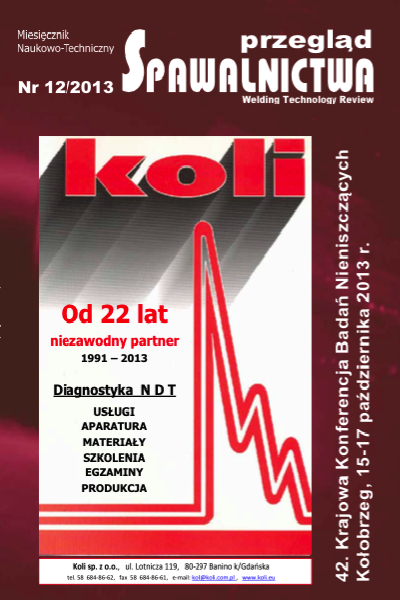Analiza możliwości oceny stopnia deformacji plastycznej stali austenitycznych metodą magnetycznej pamięci metalu
Main Article Content
Abstract
Celem badań była analiza możliwości identyfikacji obszarów odkształconych plastycznie oraz ilościowej oceny stopnia deformacji plastycznej stali austenitycznych na podstawie pomiarów własnego magnetycznego pola rozproszenia WMPR standardowymi przyrządami stosowanymi w metodzie MPM. Przedstawiono wyniki pomiarów WMPR próbek z dwóch stali austenitycznych X15Crni- Si20-12 i X2Crni18-9 o różnych stopniach trwałej deformacji. Stwierdzono, że dla stali X15CrniSi20-12 nie występują, mierzalne standardową aparaturą metody MPM, zmiany WMPR. W przypadku stali X2Crni18-9 obszary trwale odkształcone wyróżniają się na rozkładach składowych WMPR i jest możliwa ich identyfikacja. Opracowano ilościowe relacje pomiędzy stopniem deformacji plastycznej a wartościami gradientów. niestety, jednoznaczne określenie stopnia deformacji możliwe jest dopiero dla dużych jej wartości, bo dopiero powyżej 10% odkształcenia trwałego relacje stają się jednoznaczne. Ogranicza to bardzo istotnie możliwość jej praktycznego zastosowania.
Analysis of the possibility of evaluation of the degree of plastic deformation of austenitic steels using the metal magnetic memory testing method
abstract
The aim of the research was to analyze the possibility of identification of areas featuring plastic strain and quantitative evaluation of the degree of plastic deformation of austenitic steels based on measurements of the residual magnetic field (RMF) with standard tools used in the metal magnetic memory testing method. Results of the RMF measurements for samples made of two grades of austenitic steel: X15Crni- Si20-12 and X2Crni18-9 with a different degree of plastic strain are presented. It is found that for steel X15CrniSi20-12 there are no changes in the RMF that can be measured using standard MMM testing method tools. In the case of steel X2Crni18-9, the areas with plastic strain stand out in the distributions of the RMF components and their identification is possible. Quantitative relationships between the degree of plastic strain and the values of gradients are developed. Unfortunately, the degree of plastic strain can be determined unequivocally only for its large values because it is only af- ter plastic strain exceeds 10% that the relationships become unambiguous. Consequently, the possibility of applying it in practice is substantially limited.
Downloads
Article Details
Creative Commons CC BY 4.0 https://creativecommons.org/licenses/by/4.0/
Welding Technology Review (WTR) articles are published open access under a CC BY licence (Creative Commons Attribution 4.0 International licence). The CC BY licence is the most open licence available and considered the industry 'gold standard' for open access; it is also preferred by many funders. This licence allows readers to copy and redistribute the material in any medium or format, and to alter, transform, or build upon the material, including for commercial use, providing the original author is credited.
References
Żurek Z. H., Sieradzki S., Adamek J.: Ocena stanu technicz- nego kołpaków generatorów na podstawie pomiarów magnetycznych niestabilności austenitu dla stali G18H18, Przegląd Spawalnictwa (13), 2011, s. 8-12.
Vincent A. i in.: Magnetic Barkhausen noise from strain- induced martensite during low cycle fatigue of 304L austenitic stainless steel, Acta Materialia 53 (2005), 45794591.
Augustyniak B., Chmielewski M., Sablik M.J., Augustyniak M., Walker S.: A new eddy current method for nondestructive testing of creep damage in austenitic boiler tubing, nonde-structive Testing and Evaluation 24 (1-2) 2009, s. 121-141
Novotny P., Macha P., Sajdl P., Diagnostics of austenitic steels by coercivity mapping, nDT&E International 41 (2008), 530 533.
OSullivan D., Cotterell M., Meszaros I.: The characterisation of work-hardened austenitic stainless steel by nDT micro-magnetic techniques, nDT&E International 37 (2004) 265 269.
Meszaros I., Prohaszka J.: Magnetic investigation of the effect of a martensite on the properties of austenitic stainless steel, Journal of Materials Processing Technology 161 (2005), 162168.
Roskosz M.: Metal magnetic memory testing of welded joints of ferritic and austenitic steels, nDT&E International 44 (2011) 305310, doi:10.1016/j.ndteint.2011.01.008.
Roskosz M., Griner S., Staniek D., Bonik A.: Badania połą- czeń spawanych stali austenitycznych metodą magnetycznej pamięci metalu. 39 Krajowa Konferencja Badań nieniszczących, Szczyrk 2010.
Echigoya J., Ueda T., Li X.: Martensitic transformation due to plastic deformation and magnetic properties in SUS 304 stainless steel, Journal of Materials Processing Technology 108 (2001), s. 213-216.
Babiński W., Griner S.: Badania drutów ze stali austenitycznych chromowo-niklowych przeznaczonych na sita tkane, Prace Instytutu Efektywności Wykorzystania Materiałów, 1/2, 1980, s. 25.
Nagy E., Mertinger V., Tranta F.,Sólyom J.: Deformation in- duced martensitic transformation in stainless steels, Materials Science and Engineering A 2004, s. 308-313.
Hong Chul Shin, Tae Kwon Ha, Young Won Chang: Kinetics of deformation induced martensitic transformation in a 304 stainless steel, Scripta Materialia 2001, s. 823-829.
Milad M., Zreiba n., Elhalouanin F.: The effect of cold work on structure and properties of AISI 304 stainless steel, Journal of Materials Processing Technology 203 (2008), s. 80-85.
Cina B.: Effect of Cold Working on the g-a Transformation In Some Fe-ni-Cr Alloys. Journal of the Iron and Steel Institute 1977, 1954, 406.
Blanc G., Tricot R.: Transformations martensitiques dens les aciers inoxydables austenitiques Fe-Cr-ni, Mem. Sci. Rev. Metall. 7-8, 1973, 527.
Adamczyk J., Szkaradek K.: Materiały metalowe dla energetyki jądrowej, Wyd. Pol. Śl. Gliwice 1992, 236L.
